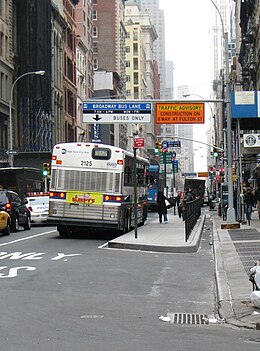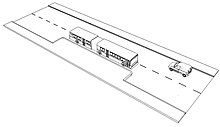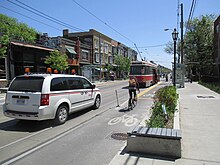
Light rail transit (LRT) is a form of passenger urban rail transit characterized by a combination of tram and rapid transit features. While its rolling stock is similar to that of a traditional tram, it operates at a higher capacity and speed and often on an exclusive right-of-way. In many cities, light rail transit systems more closely resemble, and are therefore indistinguishable from, traditional underground or at-grade subways and heavy-rail metros.

A bus stop is a place where buses stop for passengers to get on and off the bus. The construction of bus stops tends to reflect the level of usage, where stops at busy locations may have shelters, seating, and possibly electronic passenger information systems; less busy stops may use a simple pole and flag to mark the location. Bus stops are, in some locations, clustered together into transport hubs allowing interchange between routes from nearby stops and with other public transport modes to maximise convenience.

Hong Kong Tramways (HKT) is a 3 ft 6 in narrow-gauge tram system in Hong Kong. Owned and operated by RATP Dev, the tramway runs on Hong Kong Island between Kennedy Town and Shau Kei Wan, with a branch circulating through Happy Valley.

A curb extension is a traffic calming measure which widens the sidewalk for a short distance. This reduces the crossing distance and allows pedestrians and drivers to see each other when parked vehicles would otherwise block visibility. The practice of banning car parking near intersections is referred to as daylighting the intersection.

Guided buses are buses capable of being steered by external means, usually on a dedicated track or roll way that excludes other traffic, permitting the maintenance of schedules even during rush hours. Unlike railbus, trolleybuses or rubber-tyred trams, for part of their routes guided buses are able to share road space with general traffic along conventional roads, or with conventional buses on standard bus lanes.

Roncesvalles Avenue is a north–south minor arterial street in Toronto, Ontario, Canada. It begins at the intersection of Queen Street West, King Street West and the Queensway running north to Dundas Street West. At its southern starting point, King Street West traffic continues northward onto Roncesvalles Avenue unless the traffic turns east or west onto Queen Street West or the Queensway. At its northern end point, traffic continues onto Dundas Street, which is essentially a straight-line northern extension of Roncesvalles.

The L Taraval is a hybrid light rail/streetcar line of the Muni Metro system in San Francisco, California, mainly serving the Parkside District. Since 2021, the line has been suspended and replaced by buses until the end of 2024 for an improvement project along Taraval Street.

The Queensway is a major street in the municipalities of Toronto and Mississauga, Ontario, Canada. It is a western continuation of Queen Street, after it crosses Roncesvalles Avenue and King Street in Toronto. The Queensway is a divided roadway from Roncevalles westerly until 600 metres of the South Kingsway with its centre median dedicated to streetcar service. The road continues undivided west from there to Etobicoke Creek as a four- or six-lane thoroughfare.

A bus turnout, bus pullout, bus bay, bus lay-by (UK), or off-line bus stop is a designated spot on the side of a road where buses or trams may pull out of the flow of traffic to pick up and drop off passengers. It is often indented into the sidewalk or other pedestrian area. A bus bay is, in a way, the opposite of a bus bulb. With a bus bulb, the point is to save the bus the time needed to merge out of and back into moving traffic, at the cost of temporarily blocking that traffic while making a stop. With a bus bay, the goal is to not block traffic while the bus is stopped, but at the cost of the time necessary to merge back into flowing traffic. Bus bays, therefore, will generally produce longer dwell times than bus bulbs.

504 King is an east–west Toronto streetcar route in Ontario, Canada. It serves King Street in Downtown Toronto as well as Broadview Avenue on the east end and Roncesvalles Avenue on the west end of the line. The route consists of two overlapping branches: 504A between Line 2 Bloor–Danforth's Dundas West station and Distillery Loop, and 504B between Broadview station – also on Line 2 – and Dufferin Gate Loop. The two branches overlap on King Street between Dufferin and Sumach streets, both passing St. Andrew station and King station on subway Line 1 Yonge–University.
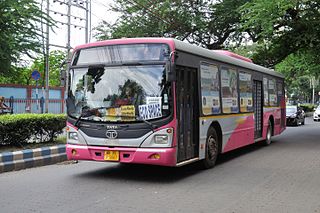
The transport system of Kolkata, a city in India, is a mix of modern mass rapid transport and old transport modalities like rickshaws. Kolkata is connected to the rest of India by the National Highways, the extensive network of the Indian Railways, National Waterways and by air. The most traffic to Northeast India route is via Kolkata.

A bus stop kerb is a special kerb designed for low-floor buses that serve an elevated bus stop platform. The usage spread after good experiences with the Kassel kerb featuring a concave-section that allows for an easier alignment for buses. The kerb was first introduced in the German city of Kassel for the low-floor tram system but has since been adopted for use at traffic stops.

A tram accident is any accident involving a tram or tram system.

Public transport bus services are generally based on regular operation of transit buses along a route calling at agreed bus stops according to a published public transport timetable.

Carl and Stanyan station is a light rail stop on the Muni Metro N Judah line, located in the Cole Valley neighborhood of San Francisco, California. The station opened with the N Judah line on October 21, 1928. It is located two blocks away from Kezar Stadium. The station has a transit bulb in the eastbound direction, which extends the sidewalk of Carl Street, to meet trains like a side platform, allowing passengers to board or depart from trains. In the westbound direction, passengers wait on the sidewalk and cross a lane of traffic to board trains. The station is not accessible to people with disabilities.

Judah and La Playa station is a light rail stop that serves as the western terminus of the Muni Metro N Judah line. It is located in the Sunset District neighborhood adjacent to the Great Highway and Ocean Beach. The station has functioned as the terminus of the N Judah line since October 21, 1928. The station has a mini-high platform for accessibility, but most passengers load trains from the street, crossing a lane of traffic to reach the sidewalks.

Turning loops of the Toronto streetcar system serve as termini and turnback points for streetcar routes in Toronto, Ontario, Canada. The single-ended streetcars require track loops in order to reverse direction. Besides short off-street track loops these can also be larger interchange points, having shelters and driver facilities, or be part of a subway station structure for convenient passenger interchange.

Road signs in Georgia are similar to the road sign system of other post-Soviet states that ensure that transport vehicles move safely and orderly, as well as to inform the participants of traffic built-in graphic icons. However, some road signs look a bit different from Soviet ones and closer to the European ones. These icons are governed by the Vienna Convention on Road Traffic and Vienna Convention on Road Signs and Signals.

The King Street Transit Priority Corridor is a transit mall located along King Street between Jarvis and Bathurst Streets in Toronto, Ontario, Canada. It passes by two subway stations on Line 1 Yonge–University. The corridor was created by the King Street Pilot Project to improve streetcar reliability on downtown King Street. The corridor went into operation on November 12, 2017, and was made permanent by City Council on April 16, 2019. The corridor is 2.6 km (1.6 mi) long and spans 18 street intersections.
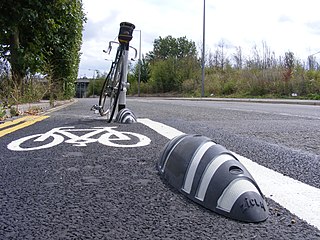
Light segregation or light protection is an engineering technique to protect cyclists using a cycle lane by placing physical objects next to the cycle lane marking.
